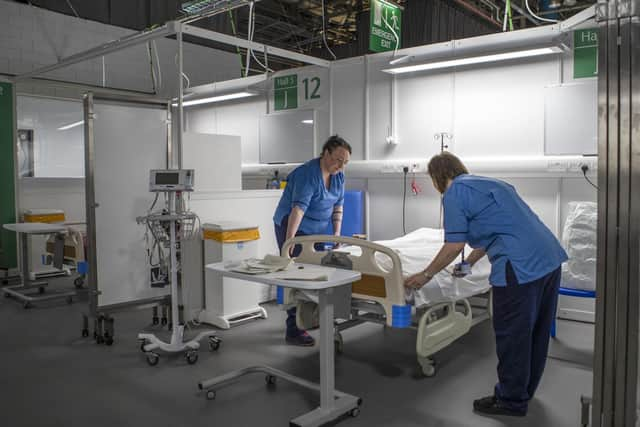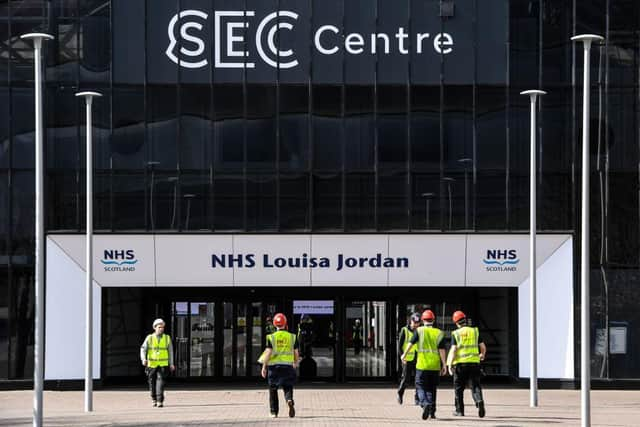Inside Scotland's new £43m Covid-19 hospital
Jill Young, chief executive of NHS Louisa Jordan, the vast temporary facility erected in Glasgow, said the “tremendous” compliance by the Scottish public with strict lockdown measures meant that there was no imminent need for the temporary hospital to begin treating people, although she emphasised it was “far too early” to make predictions about a plateau in infection rates.
The new hospital, which became operational today, will have capacity for an initial 300 patients, but the Scottish Government has said this can be expanded, if necessary, to accommodate more than three times that number, with some 1,036 bed bays in place.
Advertisement
Hide AdAdvertisement
Hide AdIf and when it begins treating people, wards of 40 beds will open on a phased basis so as to ease the potential strain on existing hospitals during the pandemic, and Ms Young said that it was ready to begin treating people at any point.


Praising the public for staying home and following social distancing measures, she said: “The reason that the health boards and the hospitals out there are coping so there is we have to give credit and thanks to the Scottish population.
“The compliance with the guidance they have been given is tremendous, which has given us hope that the numbers are not increasing as fast as we imagined they would, and that in fact they look to be plateauing, although it’s far too early to be taking any final predictions on that.
“We have to stand ready at any point in time to open. At the moment, the numbers look like we will not be required to open certainly within the next few days, and we are receiving a daily update on that.”
The facility, based in Glasgow’s SEC campus - a space ordinarily thriving with concert goers, shows, and exhibitions - will only be for Covid-19 patients who are aged 18 years or older, and It will be open for patients who do not need intensive care, or who are in the process of recovering after being in intensive care.


But Ms Young said that the hospital has “made provision for high dependency” on the basis that the condition of some patients who are admitted may deteriorate, with a 90 bed ward available if necessary.
“We have the ability to stabilise them and get them returned back by ambulance to an appropriate critical care unit," she said.
Ms Young, a former chief executive of the Golden Jubilee Hospital in Clydebank, West Dunbartonshire, said the hospital would be operational for at least the next five months, but stressed that there was the “option to extend that if it is required,” explaining that the size of the site and the infrastructure, such as oxygen supplies and “miles of cabling,” meant it would not relocate.
Advertisement
Hide AdAdvertisement
Hide Ad“We will not have to move, indeed, we could not move,” she said. “We are here for as long as is required, and I think everyone would agree with that. It’s five months initially but with an open negotiating contract to take us forward as required.”
Ms Young said a “quite complicated” triggering system was in place as part of the clinical model to ensure the new hospital can quickly accommodate patients if required.
Under the system, every health board in Scotland which reaches a certain occupancy level in either its Covid-19 wards or its intensive care units will send the information on a twice daily basis to the Scottish Government.
That data is then collated so that planners can establish which hospitals may be reaching full capacity at the quickest rate, alerting the NHS Louisa Jordan to open its first 40 bed ward and fully staff it for patients transferred from across Scotland.
The hospital itself also maintains its own “internal triggers” of occupancy rates, and reports the same information to the government.
While the NHS Louisa Jordan has yet to admit its first patients, a core of around 100 staff, who were at the hospital last week for training and inductions, will be on site to ensure infection control standards are upheld. The majority of the staff are being drawn from health boards in the west coast of Scotland, but Ms Young said she was in talks with boards on the east coast of the country and further afield.
Amid questions over the cost to the public purse of creating the site, she said final costs of the hospital will be made available in due course, and emphasised that a significant amount of the expenditure “will be reusable and reallocated back into health boards and hospitals.”
She explained: “The majority of the furniture, the equipment, the consumable supplies, will all be reallocated if they’re not required.”
Advertisement
Hide AdAdvertisement
Hide AdMs Young said all the supplies and equipment - including personal protective equipment - utilised by the new hospital were in addition to existing NHS supplies in Scotland, and that “we have not taken any supplies or equipment from any existing supplies.” They were procured through NHS NSS national procurement in the same manner all NHS Scotland equipment is sourced.
While the government hopes the £43m resource will never have to be utilised, First Minister Nicola Sturgeon said she was “perfectly comfortable” with the decision to invest in it.
Speaking at the Scottish Government’s daily briefing earlier, she said: “In the fullness of time, there may well be people - journalists and others - who look back and say, why did you do that if you didn't need it?”
“But let me be absolutely candid - I would rather be in the position of looking back and saying we invested money in something that we might have needed and didn’t need because of other thing we did, than be in a position of finding that we needed a facility like that, and we dedicated not to invest the money in it.
Almost all of the expenditure has been incurred via contracts placed by NHS National Services Scotland and using existing frameworks, which the Scottish Government says provided value for money against pre tendered rates.
Contractors involved in the construction of NHS Louisa Jordan are Balfour Beatty Group, Kier Group, Robertson Group and Graham Construction.
Ms Young paid tribute to those teams, saying: "It's just over two weeks, just look at the standard and quality of the beds here.
"It's just been incredible to bring together 700 to 800 construction workers, support teams, clinical staff, NHS teams to have designed, constructed and mobilised in over two weeks.
Advertisement
Hide AdAdvertisement
Hide Ad"It's just remarkable and my thanks go out to all of them for doing that."
She added: "These guys are experts of what they do. We do emergency planning in the NHS and we do design and construct hospitals.
"We did know the dynamics of what had to be here and what had to be aligned so in addition to what you see here, we also have all essential support."
The hospital is named after the Glasgow-born First World War nurse, Sister Louisa Jordan, who died on active service in Serbia in 1915 as part of the Scottish Women’s Hospitals for Foreign Services.
Her great nephew, Murray Crone, said it was an honour to see the emergency hospital bearing her name open its doors.
"The members of our family have been very touched by the dedication, as we have been familiar with her story for many years,” he explained.
“It is so pleasing that she would be chosen now as a representative of all the volunteers in the Scottish Women’s Hospital during WW1, coping with a Typhus epidemic in Serbia.
“And, of course, also representing all the present day medical workers doing their utmost at this time, fighting against Covid-19."
Advertisement
Hide AdAdvertisement
Hide AdA message from the Editor:Thank you for reading this story on our website. While I have your attention, I also have an important request to make of you.With the coronavirus lockdown having a major impact on many of our advertisers - and consequently the revenue we receive - we are more reliant than ever on you taking out a digital subscription.Subscribe to scotsman.com and enjoy unlimited access to Scottish news and information online and on our app. With a digital subscription, you can read more than 5 articles, see fewer ads, enjoy faster load times, and get access to exclusive newsletters and content. Visit https://www.scotsman.com/subscriptions now to sign up.
Our journalism costs money and we rely on advertising, print and digital revenues to help to support them. By supporting us, we are able to support you in providing trusted, fact-checked content for this website.
Frank O'Donnell
Editorial Director
